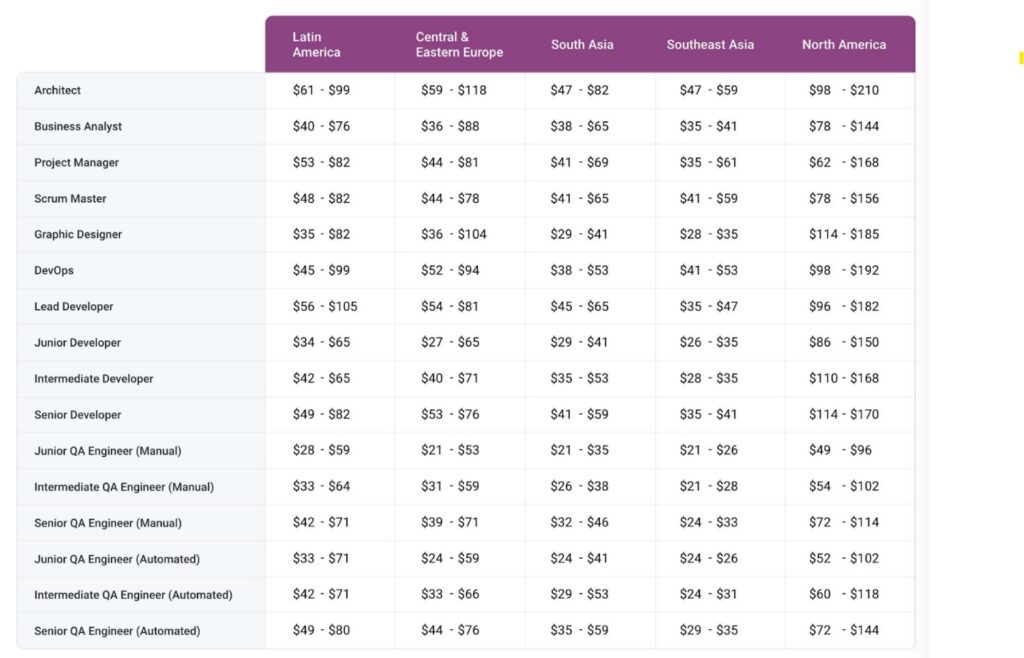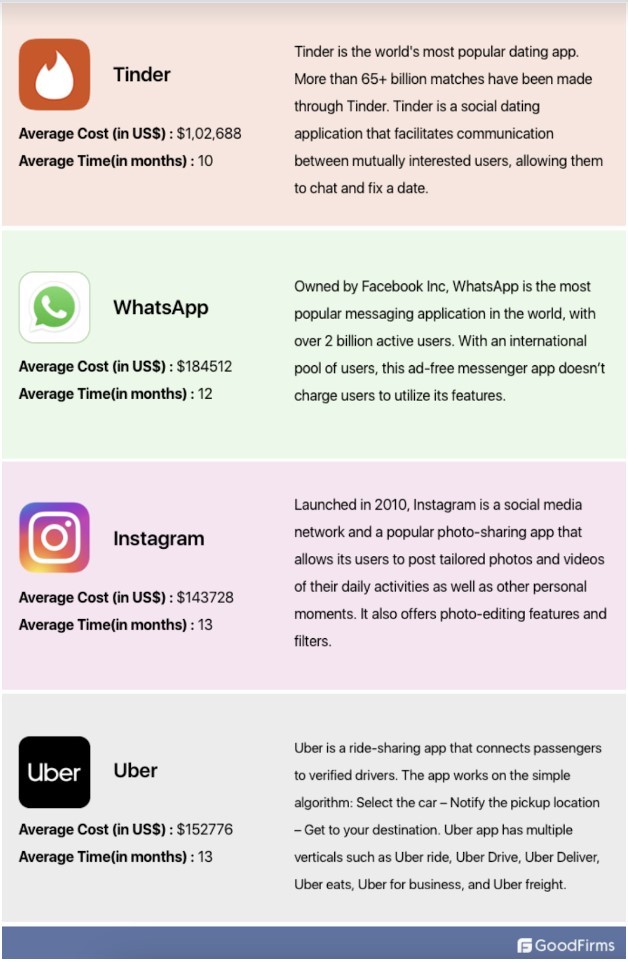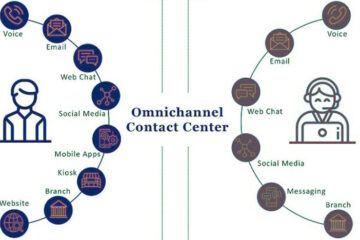Mobile apps help build strong relationships with clients. Nowadays, more people go online using mobile devices than PCs. In 2022, mobile usage totaled 55%, whereas desktop averaged 42%. And with ever-increasing screen time, building a mobile app that sits on the device is a smart business decision.
Yet this decision comes at a cost. The 2017 survey by Clutch found that just the design stage of high-quality mobile app development services in the US will cost between $5 000 to $10 000, with 16% of respondents indicating the average cost to be between $25-50 000.
Today we will look into both mobile app development outsourcing and in-house projects to see how much it can cost and what the total price consists of.
What Does the Mobile App Cost Include?
Sometimes, when we see the big numbers for software development, we get confused about why those projects cost so much. To better understand the reasoning behind prices, it helps to understand the components that the overall mobile app development cost consists of.
First of all, there are several stages of full-cycle development:
- Ideation and discovery phase to identify what user issues the app will solve and the functions it needs.
- Market research (general market condition, competition, target audience, best technology for the future mobile app).
- Idea validation (via proof-of-concept, prototyping, or MVP).
- UX/UI stage, where the front end of the mobile app is designed.
- Frontend and backend development that ensures the app functions as it should.
- QA testing to verify there are no bugs, errors, or crashes.
- Post-development maintenance.
The list seems impressive on its own, but it becomes even more so when you consider how many specialists have to be deployed throughout the process. In Emphasoft’s experience, an average mobile app takes 3 to 6 months to develop, and complex apps can easily take a year to fully prepare. So the salary and all other recurring costs will have to be multiplied by the number of months the development is continuing.
Additionally, the cost of the mobile app will be influenced by:
- Platform (if you go with a single platform, such as iOS or Android, or a cross-platform route).
- The number and complexity of features implemented.
- Mobile app development tools (such as licences for software that helps build the app).
- Add developer rates that depend on expertise, experience, the type of technology and tools they work with, and where they are based.
- Whether a software development kit (SDK) is used to streamline development or not.
- Project manager and other supporting staff rates.
- Hourly rate or stakeholders engaged in review and approval processes.
- Charges by platforms, such as App Store and Google Play.
According to Upwork, the average hourly rate of an Android developer is somewhere between $25 and $85, whereas a typical iOS developer would charge $45 to $75 for an hour of their work. The rate for the services would naturally depend on many factors, and if you have in-house staff or outsource an entire team to the software development agency, then rates can look totally different.
Upwork also shares the estimates of developer total hours that in-app features would require:
- Push notifications take 10 hours
- Map and navigation take 100 hours
- Product catalogue is 200 hours
And that includes development only, so in reality, each feature takes more hours because it will have to be thought out, validated, approved, and designed.
Accelerance has done a great job in its report defining average rates across Latin America, Central and Eastern Europe, South Asia, Southeast Asia, and North America with the summary table comparison.

The Cost of Our Favorite Apps
While we don’t know how much the most popular apps cost to build, we can estimate and guess. And GoodFirms conducted multiple surveys to find out how much apps similar to the household names would cost. Here are the numbers they came up with:
Tinder is estimated to take 10 months to develop with an approximate cost of $102 688, whereas WhatsApp requires 12 months and $184 500. Both Uber and Instagram are expected to take 13 months of work and cost $152 800 and $143 700 respectively.
The numbers above give us an estimate, but there are also many complex apps with total development costs exceeding $200 000 and even $300 000, so if your mobile app is budgeted above $200K, know that it’s a very realistic number.
Expenses Don’t Stop Once The Mobile App is Finished
The mistake that we sometimes see our clients make is only budgeting for mobile app development. However, the business continues to incur costs associated with the app even once it hits the market.
After the app is launched in app stores, the business owners will have to cover the ongoing cost of:
- Updates to add new features to stay relevant.
- Upgrades in accordance with the latest platforms’ OS editions.
- Bug fixes that inevitably come up even with best-developed apps.
- Marketing activities to draw users to the app and keep them using it.
In-House vs Freelancers vs Outsourcing
When a company decides to build a mobile app from scratch, it has three key routes it can take:
- Work with an in-house team
- Hire freelancers
- Outsource partially or completely
The cost of mobile app development depends on the business decisions. In-house development is the most costly option. A vendor would have all specialists to build an application, so additional hiring will have to happen, taking months to become permanent expense. If the project budget is limited, the business may compromise and go with cheaper developers.
Freelancing is the cheapest alternative for a small business at first glance. However, many hidden risks can drive the development cost up. First of all, freelancers are likely to have never worked together before, so additional time will be required for them to build rapport and learn to work as a team. Someone will still have to coordinate them and dedicate time from their workday to keeping track of the progress. Then, with freelancing you do not get a guaranteed quality level, so the outcome may be different from what you’ve expected. Lastly, post-launch maintenance becomes difficult when an update is required but the new hire can’t understand what was previously done by the freelancer who is now unresponsive.
Lastly, partial or complete outsourcing will likely be somewhere in the middle between freelancing and developing a mobile app in-house. With outsourcing, companies pay a premium that guarantees them access to a pool of certified professionals, a coordinated and streamlined development process, and the result achieved within the specified budget and timeframe.
Final Thoughts on the Cost of Mobile App Development
Many aspects have to be considered when a mobile app’s cost is estimated.
Many factors can drive the cost up, but thorough planning and prioritisation can also keep it under control. Building mobile apps is an art form and a science, so the key to long-term app success lies in doing the due diligence at the beginning. Companies can seek external consulting to assist them with app planning and help avoid the common mistakes that so many first-time mobile app developers bump into.
A mobile app is a long-term investment, so while the road to creating one can be tricky, it is worth paying close attention to each step of the process, being prepared for it to take longer and cost more than initially anticipated, and not rush through key development stages. If all goes well, a high-quality mobile application can turn the business around and become a powerful tool to maintain clients’ loyalty and boost sales.




1 Comment
JA · February 17, 2023 at 1:31 pm
This is gerat information. Thank you for your the details on mobile app costs